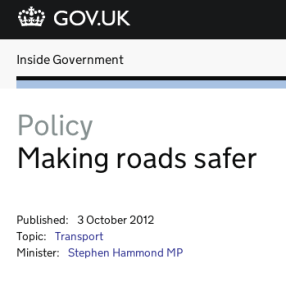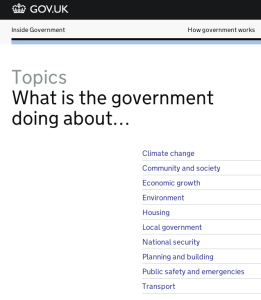
As departments move from publishing on separate websites to publishing on GOV.UK, each of them will be contributing to a comprehensive set of web pages that explain government policies clearly, consistently, and all in one place. Doing this is difficult, but we think it's important.
To get a comprehensive understanding of any policy area now, you need to know which government departments are involved. Often you will need to review more than one department’s website, and refer to a range of different types of documents (including business plans, speeches, announcements, policy papers and web pages).
You can’t be sure you’ve found everything that’s relevant, and it can be difficult to tell which information is the most definitive and up to date.
The result is that it can be difficult for people to find out what the government is doing about any given issue.
Each policy is named according to the outcome the government wants to achieve. For example, there will be policies on making roads safer, increasing the number of available homes, reducing greenhouse gas emissions from transport.

We’ve developed a template - a few simple headings - that will be used for all policies on GOV.UK. Each policy has its own page which explains the issue, actions and background, gives further detail about the actions for those who are interested, and includes a feed of announcements and publications so that users can keep up to date.
We tested this approach earlier this year and have been working with departments to refine it, ready for the first two departments to launch their policy pages when they move to GOV.UK on 15 November. We’re aiming to have a complete set of pages, representing the work of all government departments, by March 2013.
Where more than one department is taking actions to achieve the same outcome, there will be one policy which includes the actions of all relevant departments. The number of these will increase as more departments transfer their sites to GOV.UK.
We expect there will be around 250 policies in total, associated with about 40 topics (broader themes like climate change, transport and national security).

Policies are complicated things, and many people who visit departmental websites are interested in the detail of what is being done, when and how. We’re not losing the detail or necessary complexity, but we are working with departments to provide clear, succinct information.
The default language of policy - non-specific, overly complex and adjective-laden text - isn’t just unpleasant. It is confusing, impenetrable to non-experts, and open to misinterpretation. So we’re applying the GOV.UK design principles to policies, expressing them in clearer, more specific and plainer language. We’re cutting out metaphors, and trying to make paragraphs and sentences shorter and more specific.
We hope this will make policy information more accessible to a wider audience, and more useful for experts. It should provide a clearer basis for civil servants to work with others to develop policies, and a useful context for the huge amounts of data and information that departments publish.
By doing all this, we’re hoping to make it much easier for people to find the information they are looking for on any policy issue.
As ever, we are learning as we go. We’re keen to carry on improving the way we present policies on GOV.UK. If there’s anything you think we can do to make policy pages clearer and more useful once these pages are in the open, please let us know.